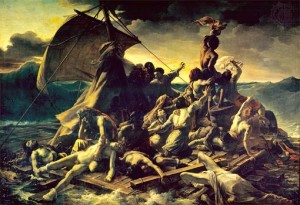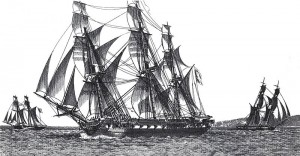Let us venture to advance another truth, a truth useful to the Minister himself. There exists among the officers of the Marine, an intractable esprit de corps, a pretended point of honour, equally false and arrogant, which leads them to consider as an insult to the whole navy, the discovery of one guilty individual. This inadmissible principle, which is useful only to insignificance, to intrigue, to people the least worthy to call on the name of honour, has the most ruinous consequences for the State, and the public service. By this, incapacity and baseness are always covered with a guilty veil, which they dare to attempt to render sacred; by this, the favours of government are bestowed at random, upon persons, who impose upon it the strange obligation of being perpetually in the dark respecting them. Under the protection of this obligation of officious silence, hitherto seconded by the slavery of the press, men without talents survive every revolution, exhibit in every antichamber their privileged incapacity, and braving public opinion, even that of their comrades, who are the first victims of a foolish and arrogant prejudice, which deceives them, shew themselves more eager to monopolise favours and honours, in proportion as they are less able to render themselves worthy of them.
Preface to: NARRATIVE OF A VOYAGE TO SENEGAL IN 1816; J.B. HENRY SAVIGNY, AND ALEXANDER CORREARD, 1817
The wreck of the French Frigate Medusa was among the notorious shipwrecks in the age of sail. The Medusa itself became a byword for corruption, incompetence and nepotism – if we were to include racism, it could be the Australian Public Service (“APS”) or the Australian Federal Police (“AFP”) we are talking about, alas the issues raised by Messer’s Savigny and Correard relate to Restoration France – which just goes to prove that the good things in life just keep on giving, but enough of my cynicism.
Beyond the political controversy of the day and the obvious parallels between the incompetence and corruption that marked Restoration France and the incompetence, racism and corruption that marks contemporary Australian politics, what really interests me about the wreck of the Medusa are two outstanding pieces of art. One contemporaneous with the events and the other a Twentieth Century the choral cantata Das Floß der Medusa (The Raft of the Medusa)written by German composer Hans Werner Henze as a requiem for one of my childhood heroes Che Guevara.
The Medusa was the flagship of a small expedition sent by sent by a corrupt and incompetent Restoration French Government to repossess the colony of Senegal from the British following the end of the Napoleonic wars. It foundered off the African coast, and while her captain, politically well-connected to the Ancien Regime,and officers sailed away in well-provisioned lifeboats, 146 men and one woman, the working class dross of French society, were herded onto a makeshift raft victualled with a few tubs of wine and some soggy biscuits.
Alexander Correard co-author of Narrative of a voyage to Senegal in 1816 was on the raft. He witnessed the navigational errors which drove the Medusa onto a sandbank, and the officer cutting the tow-rope so that the convoy of lifeboats would not be encumbered by the working class dross on the raft. Like the others, he hung bits of human flesh on lines to dry and make palatable; like the others he drank his own urine and helped throw the weakest overboard so as to conserve the last of their wine.
Of the 146 men and one woman on the raft, he was one of only 15 who survived, burned, emaciated and hallucinating, into the 12th day when another ship in Medusa’s fleet found and rescued them. Five more men died later.
Of those remaining survivors, only Correard and his co-author J.B. Henry Savigny, the ship’s surgeon, withstood bullying by the captain and officers to sign reports exonerating them for their negligence, corruption and dereliction of duty. Back in Paris they collaborated on a book describing their ordeal which became a bestseller in France and England and was used as a stick to beat the incompetent royalist old guard running France. When the regime tried to suppress the story, the Minister of Police, a liberal, bribed The Times in London 10,000 francs a month to keep the story in the public eye. If only Australia possessed such a tome of social persuasion, or more importantly a Minister of the Crown who was prepared to put reputation and treasure above self-interest!
 Gericault’s painting depicting a poignant moment in this almost unimaginable series of tragic events is now best known as the painting which sealed his reputation of one of France’s greatest painters.
Gericault’s painting depicting a poignant moment in this almost unimaginable series of tragic events is now best known as the painting which sealed his reputation of one of France’s greatest painters.
Theodore Gericault exhibited The Raft of the Medusa at the Paris Salon of 1819 and his painting is now generally regarded as an icon of Romanticism. Gericault drew his inspiration from the accounts of Messer’s Savigny and Correard.What was important for Gericault was the fact that the Medusa was captained by an officer of the Ancien Regime who had not sailed for over twenty years and who ran the ship aground on a sandbank through incompetence and the arrogant self-assurance that inhabits those of questionable ability and who rise to positions of influence and power via a corrupt system of political patronage.
Due to a shortage of lifeboats, interesting that the builders of the Titanic failed to heed the lessons of the Medusa, those who were left behind had to build a raft for 150 souls, a construction that drifted away on a bloody 13-day odyssey that was to ultimately save only 10 lives. The disaster of the shipwreck was compounded by the brutality and cannibalism that ensued.
In his painting, Gericault decided to represent the vain hope of the shipwrecked sailors: the rescue boat is visible on the horizon – but sails away without seeing them. The whole composition is oriented toward this hope in a rightward ascent culminating in a black figure, the figurehead of the boat. The painting stands as a synthetic view of human life abandoned to its fate – or as I like to see it, the fate of the workers abandoned to the fate of political and corporate greed and incompetence.
In the space of half a canvas Gericault’s manages to express the whole “raft” of human emotions: heroism, terror, resignation, horror, optimism, pessimism. Is not the man who is being borne aloft by his desperate comrades, the one who is furiously brandishing that red fragment of clothing or pennant in a kind of desperate apex of optimism, still living in hope of rescue? Is there not a tiny triple-master, the tiniest of specks, on the horizon? Oh, but it is so hopelessly far away!
And yet there is the opposite of this mood too, on the other end of that ever weakening and ever-shifting frame of wooden planks. Is not the man in the foreground, he whose head is resting with exhausted resignation on the heel of his hand, and whose other hand claws at a beautiful naked corpse whose leg hangs over that of another, as if to give some meager comfort to the naked dead, the very embodiment of doomed pessimism? There is a strange stillness in that face which stares, rapt, into the middle distance, hoping nothing.
There you have it, within the space of the width of half a canvas the hopes of humanity rise, and are then cruelly dashed again. Another very sobering detail then catches our eye: the partial sighting we get of what may be the only woman in this scene of wrenching, tormented male bodies. She is there at bottom right, one leg hooked over a broken plank. Woman? Can we really be sure that it is a woman? Well, are not those her nipples that you can see through the diaphanous white garment, which the waves have carried back over her head, almost as if to show her some modicum of respect by hiding her drowned face from us?
But it is the light in this painting which finally condemns these human beings to death. We have seldom witnessed such a ghoulish, knell-tolling light. Look how dark the enveloping atmosphere is, how suffused with the sickly smearily ghoulish green-brown-yellow of the charnel house. That dominant tone almost reeks of death, decay – the dying of the light of day, and the dying of the light of life simultaneously. Think of Gericault’s masterpiece, and remember the place of the working class dross in Europe and America, those who have and continue to pay the price of corporate and political greed and incompetence that ushered in the Global Financial Crises (“GFC”). Australia is not immune, it’s just that the treasury white Australia stole from Aboriginal Australia and is currently selling in spades to the Chinese has managed to save whities arse yet again. If the Chinese economy finally falters, working class Australia will find themselves unwanted shipmates of Gericault’s raft of fate.
Das Floß der Medusa
Like his artistic forerunner, Theodore Gericault, Hans Werner Henze’s The Raft of the Medusa proved to be the artistic (musical) scandal of West Germany in the 1960s. The first performance was scheduled for 9 December 1968 at the Planten un Blomen Hall in Hamburg. Just before it was due to begin; a student hung a large poster of Che Guevara on the rostrum rail, which was torn down by an official from NDR radio. Some students then hoisted the Red Flag and another Che portrait; some anarchists raised the Black Flag. At this point, although Henze and soloists had arrived onstage, the RIAS choir started chanting “Under the Red Flag we sing not” and left the stage. After some scuffles, the police arrived and began removing the students, taking Schnabel with them. Henze reappeared, stating that the police intervention had made a performance impossible, and led part of the audience in a chant of “Ho, Ho, Ho Chi Minh!” before they dispersed, the premiere cancelled.
By then Henze had become for many the leftist composer of the student rebellion, for others a mere salon communist or in the Australian vernacular, a Chardonnay Socialist. Henze joined the Italian Communist Party; traveled to Cuba and to East Germany. His musical language gained in militancy, sharpness and clarity, as can be heard in El Cimarron, a piece for voice and small ensemble based on the autobiography of the escaped slave Estean Montejo, made into a libretto by Enzensberger, or in the dramatic cantata Streik bei Mannesmann (Strike at Mannesmann) and in Versuch über Schweine (Essay on Pigs). The high-point: the rebellious and dramatic opera We Come to the River, revolutionary “actions for music” with a libretto by Edward Bonds, premiered at the London Royal Opera House in 1976 and recently revived at the Dresden Semper Opera.
Sidere Mens Eadem Mutato
Those readers of Blak and Black who like me attended the University of Sydney; though in my case a racist, corrupt and incompetent AFP and APS might try and argue otherwise, as in their view Indigenous Australians have not progressed far enough along the evolutionary tree to gain admittance to a tertiary institution, will recognise the aforementioned Latin phrase as being the University’s motto. While it has been said that a good motto will rarely bear literal translation, a reasonable translation of the University’s motto would be; “The constellation is changed, the disposition is the same”. Another way of putting it could be, no matter where we are on the planet human nature is as it is. The corruption that culminated in the wreck of the Medusa is the same corruption, transported by European invaders to the Southern Hemisphere that is currently witnessing the desecration and destruction of indigenous cultures all through Australasia and the wider Pacific region.
What justifies genocide in West Papua, or the cultural genocide that is the Northern Territory Intervention, or the continuing and inexplicable (unless we put it down to racism) high rates of arrest and incarceration of Indigenous Australians, or worse, but only in the Australian context, the unacceptable rates of black deaths in custody? The answer my friends is racism, greed and corruption. The same racism, greed and corruption that resulted in the wreck of the Medusa, and will ultimately be the same racism, greed and corruption that will see us all white and black alike on Theodore Gericault’s metaphorical raft unless we make a stand for what is right and for what is just!




